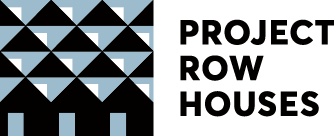History
Collective Creativity in the Beginning
Project Row Houses (PRH) is, and has always been, a unique experiment in activating the intersections between art, cultural and historic preservation, affordable and innovative housing, community engagement and development, neighborhood revitalization, and human empowerment.
Urban Landscape as Canvas
Seven visionary African-American artists working in Houston in 1993—James Bettison (1958-1997), Bert Long, Jr. (1940-2013), Jesse Lott (1943-2023), Rick Lowe, Floyd Newsum (1950-2024), Bert Samples, and George Smith—recognized real potential in a block and a half of derelict shotgun houses at the corner of Holman and Live Oak. Where others saw poverty, these artists saw a future site for positive, creative, and transformative experiences in the Third Ward. Together they began to explore how they could be a resource to the community and how art, freed from traditional studio practice, could be an engine for social transformation.
For almost thirty years, the community they built has brought together groups and pooled resources to materialize sustainable opportunities for artists, young mothers, small businesses, and Third Ward residents, helping to cultivate independent change agents by supporting people and their ideas so that they have tools and capacity to do the same for others.
The Influence of Dr. John Biggers & Joseph Beuys
Dr. John Biggers spent the majority of his life a few blocks from the area where Project Row Houses now stands. A Houston-based artist and educator whose work challenged African American stereotypes and often highlighted architecture and its significance to the community, Dr. Biggers was a teacher, friend, and mentor to many of PRH’s founders. Early conversations between Dr. Biggers and PRH founder Rick Lowe about the rich history and symbolism of the shotgun houses that dot the physical landscape of Third Ward informed and shaped the ideals of Project Row Houses.
Row houses, sometimes called shotgun houses, are modest yet elegant small homes built to capture the breeze and provide shade. The form originated in West Africa. Enslaved Africans brought the design with them, first through the Caribbean and then all along the Gulf Coast, where it radiated out and became the foremost residential style for homes built in neighborhoods where Black people settled after Emancipation.
To Dr. Biggers, shotgun houses represented not just engineering prowess, but also the ingenuity required to build a community in an often hostile climate—weather or otherwise. The repeating geometry of the row house in Biggers’ artworks have become the Rosetta stone for the architectural vernacular of Third Ward. They are the building blocks of creative placekeeping of the African diaspora in the American South.
Mindful of the history and depth of the symbolism of the row houses when they acquired the first 22 houses, the founders were also inspired by the philosophy of artist and activist Joseph Beuys. Beuys, practicing in Germany in the second half of the 20th century, coined the term social sculpture to describe the way in which people working together to shape the world around them becomes art.
Urban renewal is well underway in Third Ward. The most recent census data shows that the number of Black families making their homes here has fallen. Property values are rising, and new neighbors are coming.
The challenge facing Third Ward and Project Row Houses has never been more urgent—how can we shift the forces of gentrification to ensure that the economic vitality and infrastructure updates that come with it benefit our legacy Black residents and create the space and opportunity for them to remain in Third Ward alongside newer neighbors?
Collective creative action continues to be the organizing principle at Project Row Houses. It is not our intent to create a museum to a culture that once was, to preserve homes as shells and reminders of a storied past. Project Row Houses succeeds as a social sculpture when Black art, culture, and community are protected, promoted, elevated, and celebrated in new and vibrant ways that honor the past but build a dynamic, diverse, and unique future.
Learn more about our programs here.
For more information about our founders, history, and the organization, click here.
Help Materialize
Sustainable Opportunities
In Marginalized Communities.



